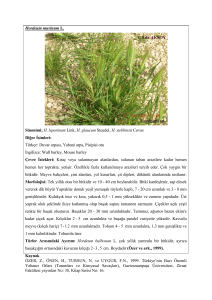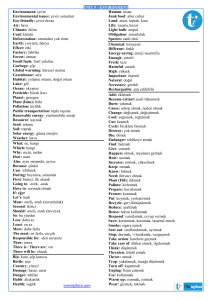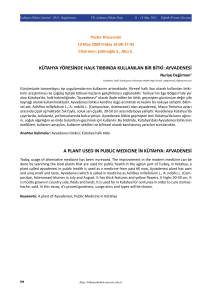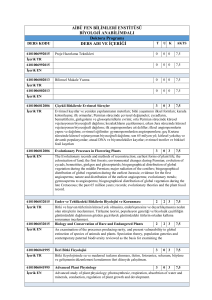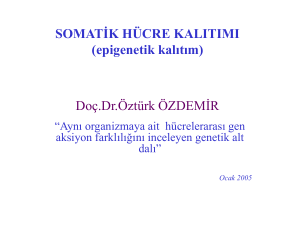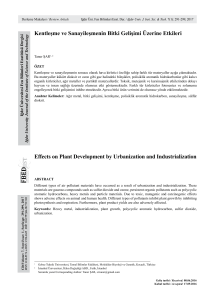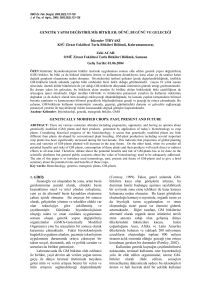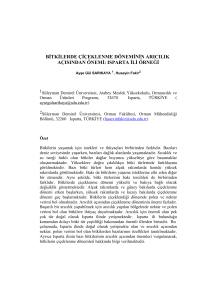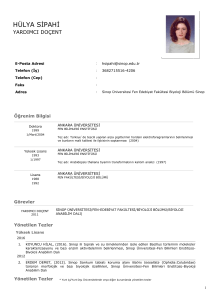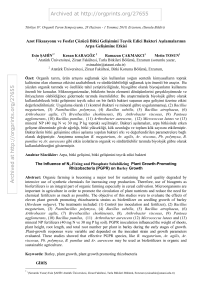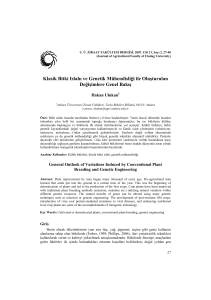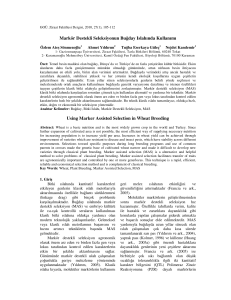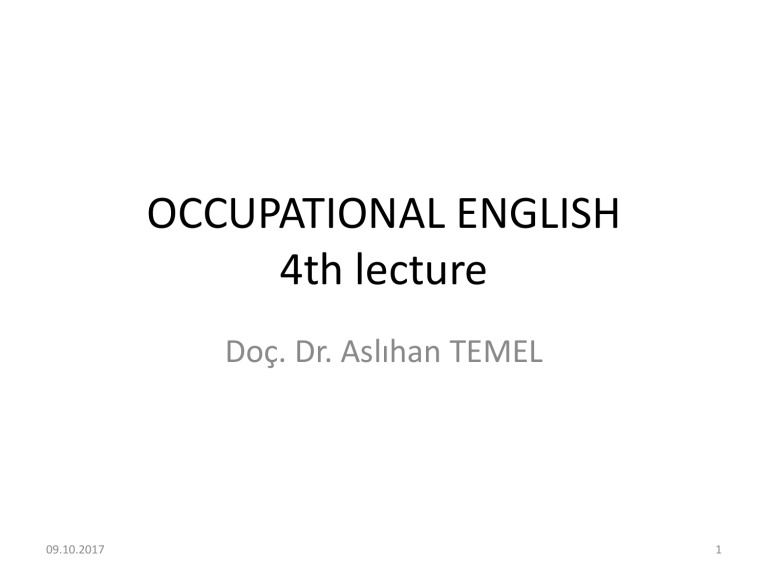
OCCUPATIONAL ENGLISH
4th lecture
Doç. Dr. Aslıhan TEMEL
09.10.2017
1
Methylation of cytosine residues in DNA provides a mechanism
of gene control. There are two classes of methyltransferase in
Arabidopsis; one has a carboxyterminal methyltransferase
domain fused to an amino-terminal regulatory domain and is
similar to mammalian methyltransferases. The second class
apparently lacks an amino-terminal domain and is less well
conserved. Methylcytosine can occur at any cytosine residue,
but it is likely that clonal transmission of methylation patterns
only occurs for cytosines in strand-symmetrical sequences CpG
and CpNpG. In plants, as in mammals, DNA methylation has dual
roles in defense against invading DNA and transposable elements
and in gene regulation. Although originally reported as having no
phenotypic consequence, reduced DNA methylation disrupts
normal plant development.
09.10.2017
2
DNA’daki sitozin birimlerinin metilasyonu, gen kontrol
mekanizması sağlar. Metiltransferazın, Arabidopsis’te 2 sınıfı
vardır;
birincisinin,
karboksi-terminal
domene
bitişik
karboksierminal metiltransferaz domeni vardır ve memeli
metiltransferazlarına benzer. İkinci sınıf, görülüyor ki,
aminoterminal domen içermez ve daha az korunmuştur.
Metilsitozin, herhangi bir sitozin biriminde oluşabilir ancak
metilasyonun klonal aktarımının, sadece simetrik diziler olan CpG
ve CpNpG ‘deki sitozinlerde oluşması daha olasıdır. Bitkilerde,
memelilerdeki gibi, DNA metilasyonunun, istilacı DNA ve Teler
karşı savunmada ve gen düzenlenmesinde ikili rolü vardır. Daha
önce, fenotipik snuçlarının olmadığı bildirilmesine karşın; azalmış
DNA metilasyonu, normal bitki gelişimini bozar.
09.10.2017
3
DNA Methylation in plants
09.10.2017
4
Plant peroxidases (class III peroxidases) are present in all land plants. They
are members of a large multigenic family. Probably due to this high
number of isoforms, and to a very heterogeneous regulation of their
expression, plant peroxidases are involved in a broad range of
physiological processes all along the plant life cycle. Due to two possible
catalytic cycles, peroxidative and hydroxylic, peroxidases can generate
reactive oxygen species (ROS) (•OH, HOO•), polymerise cell wall
compounds, and regulate H2O2 levels. By modulating their activity and
expression following internal and external stimuli, peroxidases are
prevalent at every stage of plant growth, including the demands that the
plant meets in stressful conditions. These multifunctional enzymes can
build a rigid wall or produce ROS to make it more flexible; they can
prevent biological and chemical attacks by raising physical barriers or by
counterattacking with a large production of ROS; they can be involved in a
more peaceful symbiosis. They are finally present from the first hours of a
plant’s life until its last moments. Although some functions look
paradoxical, the whole process is probably regulated by a fine-tuning that
has yet to be elucidated. This review will discuss the factors that can
influence this delicate balance.
09.10.2017
5
Bitki peroksidazları (tip III peroksidaz), tüm kara bitkilerinde
mevcuttur. Büyük multigen ailesnin bireyleridir. Büyük olasılıkla,
çok sayıda izoformlarından ve anlatımlarının heterojen
düzenlenmesinden dolayı, bitki peroksidazları tüm bitki yaşam
döngüsü boyunca çok geniş kapsamlı fizyolojik süreçlerle
ilişkilidirler. Peroksidatif ve hidroksilik şeklinde 2 adet olası
katalitik döngüden ötürü, peroksidazlar, reaktif oksijen türleri
oluştururlar; hücre duvarı bileşenlerini polimerize ederler ve
H2O2 seviyesini düzenlerler. Bu çok yönlü enzimler, sağlam bir
hücre duvarı oluşturabilir veya ROS üreterek daha esnek bir hale
getirebilir; fiziksel bariyer oluşturarak veya fazla miktarda ROS
üretip karşı saldırıda bulunarak, biyolojik ve kimyasal saldırıları
önleyebilir, daha barışçıl bir simbiyoz ile ilişkili olabilirler. Bitki
yaşamının ilk saatlerinden, son anlarına kadar mevcutturlar. Bazı
işlevleri çelişkili görünse de, tüm süreç henüz aydınlatılmamış bir
ince-ayar ile düzenleniyor olabilir. Bu derleme, bu hassas dengeyi
etkileyebilen
etmenleri tartışacaktır..
09.10.2017
6
Peroxidases have more functions than a
Swiss army knife
09.10.2017
7
Environment-sensitive plant development follows a program inscribed in
the DNA, and differential expression of the genes is the prerequisite of
this program. In the last decades, it was possible to unravel how genes are
correctly transcribed in time and space by interaction of trans-acting
factors with cis elements often located in the promoter of a gene.
However recently, we learned that, in addition, another level of control,
called epigenetic regulation, acting via alterations in chromatin structure
is involved. In this review, we will first summarise the basic mechanisms
underlying epigenetic control of gene expression in plants. In the
following article, we will focus on some selected recent results showing
epigenetic control of major steps in plant development. This review can
not cover all new results in the field and we want to apologise to all who
are not mentioned.
09.10.2017
8
Çevreye duyarlı bitki gelişimi, DNA’da belirlenmiş bir programı takip eder
ve genlerin farklı anlatımı bu programın gereksinimidir. Son on yıllar
boyunca, genlerin, bir genin promotör bölgesindeki cis elementlerin ve
trans elementlerin etkileşimleri ile, nasıl doğru zaman ve doğru yerde
anlatım yaptığını anlamak mümkün olmuştur. Ancak, yakın bir geçmişte,
kromatin yapısına etki eden ve epigenetik düzenlenme adı verilen başka
bir kontrol düzeyinin e ilişkili olduğunu öğrendik. Bu derlemede öncelikle
bitkilerde gen anlatımının epigenetik kontrolünü oluşturan temele
mekanizmaları özetleyeceğiz. Makalenin ilerleyen kısmında ise, bitki
gelişimindeki başlıca adımların epigenetik kontrolünü gösteren, yakın
zamanlı ,seçilmiş bazı sonuçlara odaklanacağız. Bu derleme, alandaki tüm
yeni sonuçlara kapsamayabilir ve adı geçmeyen herkesten özür dilemek
istiyoruz.
09.10.2017
9
Epigenetic Regulation in Plants
09.10.2017
10
In this study, it was aimed to compare salinity-induced changes in barley
(Hordeum vulgare L. cv. Bornova-92) and bread wheat (Triticum aestivum
L. cv. Gerek-79). Seeds were germinated under saline conditions (0, 50,
100, 250, and 500 mM NaCl) for 2 days and recovered under non-saline
conditions for 2 days. At the end of the salt treatment, germination, water
content (WC), total soluble protein content, and catalase (CAT) activity
were affected in both species, while superoxide dismutase (SOD) activity
was affected in barley. Salinity affected WC, protein content, and CAT
activity in both species, while it affected germination in barley and
affected fresh weight and SOD activity in wheat after recovery.
Physiological responses of both species were correlated. Expression of αtubulin, Atls1, and Lls1 genes was down-regulated in barley after 250 mM
NaCl treatment. HVA1 gene was highly (more than 50-fold) stimulated by
salinity in barley. However, α-tubulin and Atls1 genes were downregulated, and Lls1 gene was up-regulated in wheat after recovery from
250-mM NaCl treatment. Increase in HVA1 expression was not significant
in wheat. The expression profiles of barley and wheat under salinity are
different, and barley tended to regulate gene expression faster than
wheat.
09.10.2017
11
Bu çalışmada, arpa ve ekmeklik buğdayda, tuzluluğun yol açtığı
değişimlerin karşılaştırılması amaçlandı. Tohumlar tulu koşullarda 2 gün
boyunca çimlendirildi ve tuzlu olmayan koşullarda 2 gün boyunca
iyileşmeye bırakıldı. Tuz uygulamasının sonunda, çimlenme, su içeriği,
toplam çözünebilir protein içeriği, ve katalaz aktivitesi her 2 türde de
etkilenirken; süperoksit dismutaz aktivitesi arpada etkilendi. İyileşmeden
sonra ise, tuzluluk, WC, protein içeriği ve CAT aktivitesini her 2 türde;
çimlenmeyi arpada, taze ağırlık ve SOD aktivitesini buğdayda etkiledi. Her
2 türün fizyolojik yanıtları korelasyon gösterdi. 250 mM NaCl uygulanmış
arpada, α-tubulin, Atls1 ve Lls1 genlerinin anlatımı azaldı. HVA1 geni
arpada tuzluluğun etkisiyle oldukça fazla (50 kattan daha fazla) uyarıldı.
Ancak, 250 mM NaCl uygulandıktan sonra iyileşmeye bırakılan buğdayda,
α-tubulin and Atls1 genleri baskılanırken; Lls1 geni uyarıldı. HVA1 geninin
anlatımındaki artış buğdayda anlamlı değildi. Arpa ve buğdayın tuzluluk
altındaki anlatım profilleri farklıdır ve arpa, gen anlatımını, buğdaya göre
daha çabuk düzenlemeye meyillidir.
09.10.2017
12
Physiological and Molecular Changes in
Barley and Wheat Under Salinity
09.10.2017
13
To minimize the presence of RNases, it is important to keep equipment
aside for use only with RNA extractions. Pipet tips and Eppendorf tubes
should be used only for RNA work and not mixed. Gloves should be used
at all times. Keep one set of gel electrophoresis equipment for use just
with RNA. Keep solutions Rnase free by not using the solutions in other
procedures. Always use RNase-free water for solutions. The solid
chemicals are NOT RNase free, therefore, buffers should be autoclaved.
Tris-HCl buffers cannot be autoclaved.
Refer to the manufacturer’s instructions and guidelines for stability and
storage, and handle with eye and glove protection.
09.10.2017
14
RNazların varlığını minimuma indirmek için, ekipmanları yalnızca RNA
ekstraksiyonunda kullanılmak üzere ayırmak önemlidir. Pipet uçları ve
Eppendorf tüpler sadece RNA işleri için kullanılmalı ve karıştırılmamalıdır.
Her durumda eldiven kullanılmalıdır. Bir jel eletkroforez seti sadece RNA
için kullanılmak üzere saklanmalıdır. Çözeltileri, diğer çalışmalarda
kullanmayarak, RNaz içermeyen halde kalmalarını sağlayın. Çözeltilerde
daima RNaz içermeyen su kullanın. Katı kimyasallar RNaz içermeyen halde
değildir bu yüzden tamponlar otoklavlanmalıdır. Tris-HCl tamponları
otoklavlanamaz.
Uzun süre saklayabilmek ve stabil durumda utabilmek için üreticinin
talimatlarına kılavuz bilgilerini inceleyin ve göz ve eldven koruması ile
çalışın.
09.10.2017
15
An essential task in any molecular genetics laboratory is the
isolation of genomic DNA (gDNA). Numerous DNA isolation
protocols use phenol and chloroform to separate cellular
molecules and debris from the DNA. Such
organic reagents are toxic, hazardous, expensive, and require
special containment facilities to maximize personnel safety and
minimize environmental concerns. The disposal of
phenol/chloroform waste also requires special equipment and
care to avo id human and environmental exposure. The lack of
well-equipped laboratories, particularly those in many
developing countries, may prohibit the use of harmful chemicals.
09.10.2017
16
Moleküler genetik lablarındaki başlıca bir görev genomik DNA
(gDNA) izolasyonudur. Çok sayıdaki DNA izolasyon protokolü,
hücresel molekülleri ve kalıntıları DNA’dan uzaklaştırmak için
fenol ve kloroform kullanır. Bu tür organik bileşikler toksik,
sağlığa zaralı ve pahalı olup; çalışanların güvenliğini arttırmak ve
çevresel sorunları azaltmak için özel depolama birimleri
gerektirir. Fenol/kloroform atıklarının uzaklaştırılması da, insan
ve çevre kontaminasyonunu engellemek için özel ekipman ve
uğraş gerektirir. İyi donanımlı labların olmayışı, özellikle
gelişmekte olan çok sayıdaki ülkede, zararlı kimyasalların
kullanımını yasaklayabilir.
09.10.2017
17
M: 1 kb ladder. The biggest band in
lane M is 10 kb.
1-4 are, respectively, apple, grape,
pear and cherry genomic DNA
Equal volume of DNA
1% agarose gel and ethidium
bromide
09.10.2017
18
Genomic DNAs were isolated from apple, grape, pear and
cherry plants. Genomic samples were resolved on 1% agarose
gel containing ethidium bromide and compared to a 1kb DNA
ladder.
All samples had 1 DNA band much bigger than 10 kb indicating
the presence of intact (high molecular weight) DNA. Apple
sample had the most concentrated DNA.
09.10.2017
19

